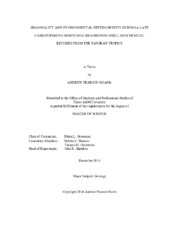| dc.description.abstract | The relationship between Permo-Carboniferous glacial cycles and low-latitude climate remains a subject of vigorous debate. This study investigated seasonality and regional environmental variability in a portion of central equatorial Pangea during a late Pennsylvanian highstand using stable isotope and trace element analyses of brachiopod shells from the Virgilian Ames Member of the Conemaugh Group in the Appalachian Basin, U.S.A. Well-preserved, thick-shelled Neospirifer dunbari specimens were serially sampled across growth bands to elucidate a record of seasonal variability during the life of the organisms. Because Neospirifer only colonized this marginal basin during near-maximum highstands when stable marine salinities were established, these data are a direct proxy for intra-annual climate fluctuations during interglacial times. Additionally, well-preserved specimens of the thinner-shelled brachiopod Crurithyris planoconvexa, which has a wider spatial and stratigraphic distribution within the basin, were analyzed individually.
Neospirifer specimens show remarkably little internal chemical variability, with δ^18O generally fluctuating by 0.4‰ or less and δ^13C by less than 1.5‰ within a single specimen. Moreover, total variability between all specimens is only ~1.5‰. This lack of variation reflects a homogenous, nonseasonal to weakly seasonal climate during the Ames highstand. Both δ^18O and δ^13C are ~1.5 lower than those of other Virgilian specimens from regions with a more proximal connection to the open ocean, suggesting relatively high freshwater influence in the Appalachian Basin during this time, although salinities remained close to marine levels. Thus, brachiopod seasonal records indicate normal moist tropical conditions during this penultimate Carboniferous interglacial, with no evidence for strong monsoonal variations in temperature or rainfall. Crurithyris specimens show similarly homogenous isotopic values that are slightly depleted relative to more nearly marine specimens. There is a weak gradient towards increasing δ^18O and δ^13C in Crurithyris specimens to the west, consistent with decreasing influence of Appalachian runoff waters in that direction. Crurithyris from two sites show anomalously enriched isotopic values, potentially indicating rare, sporadic periods of net evaporation. However, because of Crurithyris’ wider temporal distribution, these events may not have occurred during the highstand. | en |


